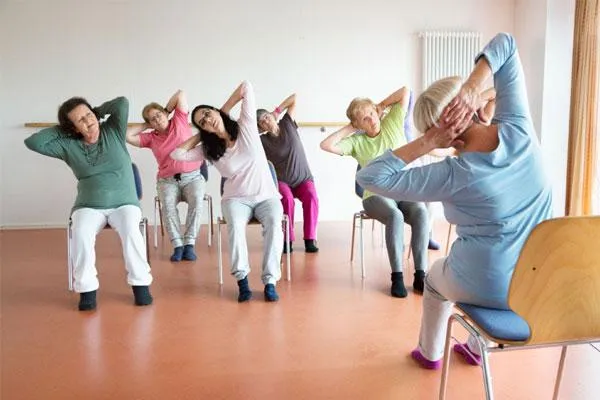
PWN Wellness Trends Aug 26 2025
Chair Yoga in the U.S. (2025): Accessible Mobility, Stress Relief, and Real-World Impact
Medical note: Informational only; not a substitute for professional advice. People with recent surgery, uncontrolled hypertension, glaucoma, severe osteoporosis, or balance/neurologic issues should consult a clinician before starting.
What Is Chair Yoga—and Why Now?
Chair yoga adapts classic yoga poses so they’re performed seated or using a chair for support. It keeps the benefits (mobility, breathwork, balance, stress reduction) while lowering barriers: no floor work, minimal space, and regular clothes are fine.
Why it’s trending:
Accessibility: Suitable for beginners, older adults, people returning from injury, larger bodies, and desk-bound workers.
Convenience: Short sessions fit between meetings or at community centers.
Evidence-aligned goals: Gentle movement + slow breathing supports range of motion, pain self-management, and stress physiology.
Hybrid delivery: Streams well on video; easy to standardize for workplaces and benefits programs.
Evidence Snapshot (Plain-English)
Mobility & function: Gentle, repeated range-of-motion and isometrics can improve flexibility, joint comfort, and activities of daily living—particularly for adults with sedentary lifestyles or mild osteoarthritis.
Balance & falls: Supported balance drills (sit-to-stand, heel-to-toe with chair contact) help train ankle/hip strategies and confidence—key to fall risk reduction when progressed carefully.
Stress & sleep: Slow nasal breathing and extended exhalations stimulate parasympathetic tone, often improving perceived stress and sleep quality.
Pain coping: Breath-movement synchronization builds interoceptive awareness and reframing of pain sensations, supporting non-pharmacologic pain strategies.
Cardio-metabolic light dose: Continuous sequences elevate light activity time, which is independently associated with better metabolic health in sedentary adults.
Reality check: Effects depend on consistency (2–4×/week), appropriate progressions, and pairing with walking/strength for comprehensive fitness.
Who’s Doing It? Consumer Insights (2025)
Office workers/remote teams: 10–20-minute breaks reduce stiffness and screen fatigue; HR teams book monthly series.
Active agers (55+): Value joint-friendly movement and social connection; prefer predictable routines and familiar music.
Rehab/return-to-movement: People easing back after musculoskeletal issues like knee/hip pain appreciate support and controlled ranges.
Plus-size and new-to-fitness audiences: Chair support reduces intimidation; classes marketed as “gentle mobility + breath” outperform generic “yoga” labels.
Mindful micro-break seekers: Short “reset” sessions for mood regulation between tasks.
Purchase drivers: certified instructors, clear safety cues, no-sweat format, options (seated-only vs. supported standing), and hybrid delivery (live + recorded library).
Class Formats That Work
Seated-only (10–20 min): Spine mobility, shoulders/hips, wrists/ankles, breathwork.
Seated + Supported Standing (20–35 min): Add balance drills, mini-flows, gentle leg strengthening.
Targeted sessions:
Desk relief: neck/upper-back decompression.
Hips & low back: figure-4 variations, pelvic tilts.
Sleep wind-down: longer exhale breathing, forward folds, eyes-closed body scan.
Equipment: stable chair (no wheels if possible), flat shoes or barefoot, optional yoga strap/towel and light ball/block.
Safety & Contraindications (Teach to These)
Glaucoma/eye pressure: minimize long head-below-heart holds; avoid forceful breath retentions.
Uncontrolled BP/cardiac issues: favor gentle ranges; avoid Valsalva; keep breath smooth.
Osteoporosis: avoid loaded spinal flexion/rotation end ranges; choose neutral-spine mobilizations.
Post-op/joint replacements: respect surgeon/PT timelines; avoid twisting under load.
Dizziness/vestibular issues: transition slowly; eyes-open balance; seated options ready.
A 12-Minute Chair Yoga Flow (Copy for Class or Article Sidebar)
1) Arrival & Breath (1:00)
Sit tall, feet hip-width, hands on ribs. Inhale 4, exhale 6 (nasal if comfortable), ×6 breaths.
2) Spine Waves (1:30)
Cat-cow seated: inhale lift chest, exhale round gently. 6–8 cycles.
Add side bends: right/left with one arm overhead, 3 each.
3) Shoulders & Upper Back (1:30)
Scapular circles: up-back-down-forward ×6 each way.
Eagle-arms (or hug): 3 breaths each side.
4) Hips & Ankles (2:00)
Marches seated ×20 total.
Ankle circles ×6 each direction.
Figure-4 (ankle over knee or shin) — hinge slightly, breathe ×5 each side.
5) Hamstrings (1:30)
One heel forward, toes up, hinge from hips, long spine, 4–5 breaths each side.
6) Supported Standing (optional, 3:00)
Sit-to-stand with chair support ×8–10 (slow, controlled).
Heel-to-toe balance hold 15–20 s each side with fingertips on chair.
Mini calf raises holding chair ×12.
7) Reset & Downshift (1:00)
Seated forward fold over thighs, breathe 3–5 cycles.
Finish with 5 breaths (inhale 4, exhale 6–8). Short gratitude note.
Progressions: add light resistance band rows, longer single-leg stance with chair touch, or 20–25-minute sequences.
Programming for Organizations (Workplace / Community / Healthcare)
Workplace: 2× weekly live 15-minute sessions + on-demand library; add “posture pop-ups” near lunch.
Senior/community centers: 30-minute classes with more social time; closed captions; printed take-home cards.
Clinics/benefits: Offer chair yoga within musculoskeletal or stress-management tracks; pre-class screen; track outcomes (pain scores, sit-to-stand reps, self-rated stress/sleep).
Metrics that resonate: attendance, session completion, sit-to-stand gains in 4–8 weeks, self-reported stiffness, and PHQ-4 stress/anxiety trends.
U.S. Market Implications
Studios & instructors: Chair yoga expands total addressable market; afternoon “desk reset” slots show high utilization online.
Employers & payers: Low cost per participant; fits into MSK and mental-wellness bundles.
Hardware & content: Growth in ergonomic chairs, short-format video libraries, and enterprise licensing for HR portals.
Equity: Highly scalable in libraries, churches, and housing communities—requires minimal gear and can be taught bilingually.
FAQs (use in your sidebar)
Is chair yoga “enough” exercise?
It’s a valuable mobility + balance + stress modality. Pair with walking (aerobic) and 2×/week strength for a complete routine.
How often should I do it?
Start with 10–15 minutes, 3 days/week, and build to 20–30 minutes most days.
Can I lose weight with chair yoga?
It supports behavior change and reduces aches that limit activity. Weight change depends on overall activity and nutrition.
Do I need a yoga mat?
No—just a stable chair and safe floor space.









